| BUILDINGS & FACILITIES |
YEAR: 1962
HUB RAIL
Extract from Executive News.
An application from the Addington Trotting Course Ltd, supported by the NZ Metropolitan Trotting Club, to replace the existing inner track fence at Addington with that of a hub type running rail similar to that used at Yonkers Raceway in the United States was approved by the NZ Trotting Conference Executive at it's meeting last week, on the condition that it would be replaced if not proved successful to NZ racing conditions.
Credit: NZ Trotting Calendar 19Sep62
YEAR: 1960
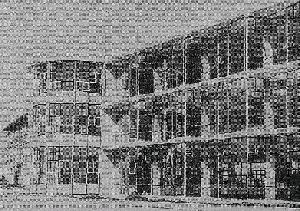 |
The new Grandstand at Addington viewed from the rear shows the new amenities block which will be used for the first time on Cup Day (1960).
With lounges, bar, totalisator facilities and restaurant, patrons do not have far to move from the stand on the northern side.
The large circular bay windows give a clear view of the totalisator dividend indicators.
Credit: NZ Trotting Calendar 9Nov60
YEAR: 1950
1950 CUP DAY TOTAL A RECORD
The return of NZ Trotting Cup day to the traditional Tuesday of Carnival Week proved an unqualified success. All the forebodings of the timorous that mid-week racing would decimate the totalisator returns proved groundless, the total of the day, £211,977, being a new record for a days racing in the South Island and also a record for a trotting meeting. Of this sum, £15,278 was invested on the double.
Addington, recognised as the NZ headquarters of trotting, looked better on Tuesday than it has ever looked before. The scene was gayer than ever. Many thousands of people continue to make Cup day at Addington their 'day of the year.' The previous record attendance at any fixture, apart from international rugby tests at Lancaster Park, was recorded on Cup Day last year, October 29, a Saturday. The crowd was 34,000, and the then record total of £211,293 was established, £40,717/10/-being invested on the Cup alone. The year's Cup total was £40,203/10/-, a result far exceeding the expectations of even the most optimistic.
Many workers took the day, or part of it off, and in a number of factories employees requested time off and promised to make it up by working extended hours at ordinary rates. Before 1942, when the Cup was always run on a Tuesday, thousands journeyed to Addington for a two-hour lunch break to see the Cup and one other race, but this year the Cup was not run until 2:17pm. When the 1941 Cup attendance of 19,000 is compared with crowds of more than 30,000 this year and last year, the great strides in the popularity of trotting in Christchurch are measured. The trainers and drivers in trotting are public personalities, and the horses, their breeding, their performances, their best times, and their characteristics are as the A B C to all followers. With races being held on a six-furlong track, the horses are in view without the use of binoculars - except for those not endowed with height jammed in the crowd - and the intimacy of trotting at Addington is one of the causes of the phenomenal increase in popularity with the public.
Additional betting facilities were available on Tuesday, additional turnstiles have greatly reduced the length of queues, and a large marquee erected on the lawn enclosure behind the main stand has improved the catering appreciably. A scheme of tree-planting and attractive gardening displays give the whole scene a pleasant 'new look' and this part of the club's plan is only in its infancy.
To give all patrons a clearer hearing of the commentaries on the races by Mr D B Clarkson (now established as a notable contributor to the enjoyment of a day at Addington) all the loud speakers have been brought across the tracks to the outer fence and a new loud-speaker has been placed on a pole on the lawn inside the track to provide for the thousands who watch the races from there on Cup days. Men to open the gates and rake the track from the outside enclosure are always on duty at meetings at Addington, but the general public do not seem to realise that the inside of the course is always available to them. The inside enclosure is now one huge lawn, the section at the top end having been levelled and grassed.
The grey drabness of the concrete of the stands had largely disappeared under a spray of plastic paint. All the stands would have been painted by now had the supplies of the paint been available.
Another work of priority which could not be carried out before the Cup meeting was the building of semi-permanent seating on the mound in front of the tea kiosk, wittily called by patrons 'Coopers Knob,' after the course superintendent and the prominent landmark on the Port Hills. The open stand will seat about 2000.
"The people would see on Cup day the progress we are making to give them the best facilities." said the president of the NZ Metropolitan Trotting Club, Mr C S Thomas. "We are only beginning a long-term programme to make Addington the finest possible trotting course." As the administrative head of the Metropolitan Trotting Club, Mr H E Goggin is responsible for every detail. The totalisator manager (Mr Arthur Toon) had a staff of 423 on Tuesday, and the other workers on gates, stairs and cloakrooms number 180. In addition, 450 were working on catering.
Credit: NZ Trotting Calendar 8Nov50
YEAR: 1946
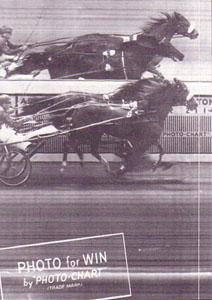 |
Photo-chart cameras are now installed on all the leading racecourses in the Dominion. This article is written to explain what is virtually a new idea in photography and to explain some of the many questions that are often asked about 'photo-finish.' Technicalities have been avoided as much as possible.
It is interesting to note that the original development of the movie camera was closely associated with racing, and was, in fact, evolved from experiments made with a series of ordinary fixed cameras fitted round a racetrack to take a sequence of pictures of horses galloping, these pictures later being pieced together to give some idea of sequence of movement.
Later there was developed a movie camera with a synchronised shutter to produce a series if still pictures of 'frames' which is the basis of the ordinary moving picture in use today. For some time high-speed movie cameras were used for deciding the finish of races, but were abandoned owing to the fact that, firstly, it commonly happened to be a point between two 'frames' on the film. Consequently the judge had to interpolate between the picture taken just before and the picture taken just after the actual finish. Secondly, there was the disadvantage that camera shutters did not photograph both inside and outside horses with equal advantage.
The first big advance to be made in the recording of race finishes was the innovation of what is known as the 'continuous strip' or 'slit' camera. The principle of this camera is that no shutter is used, but in its place is fitted a very narrow vertical slit with an opening of a few thousandths of an inch which enables the camera to 'see' across a narrow strip of track only a few inches wide right across the finish line. The film in the camera moves continuously past this slit at a speed synchronised with the speed of the horses. The camera is so set up that a horse is not photographed until it actually reaches the finish line and each horse in turn is recorded on the film as it passes the finish.
This system was used to quite a consideable extent in America, but did not find great favour due primarily to the fact that the photograph gave no indication whether or not the camera was accurately aligned across the finish line when the photogragh was taken. In other words there was nothing to show whether it took a photograph several feet before or after the finish. Another objection to this camera was the fact that there was no proof that a photograph of any race was in fact the photograph it putported to be. A few years ago what is known as the 'spinner' was invented and this revolutionised the whole situation.
The 'spinner' comprises a revolving drum fitted on the inside of the track at the finish line and rotating at a speed equivalent to the speed of the horses. On the outside of this drum is inscribed the name of the track, the number of the race and date, and a series of vertical lines, all of which are photographed on the film simultaneously with the horses. The written items which appear on every film give complete evidence of exactly what race is recorded with no possibility of error.
The vertical lines provide the answer to a question often asked: Where is the winning post? These lines are drawn exactly vertical to the actual finish line and, therefore, as the photograph is taken each one of these lines is a finish line. It must be remembered that the camera only photographs what happens at the winning post and provides a record of the order in which the horses pass, no horse being photographed either before or after the actual finish line.
At the end of the race if a photograph is called for by the judge, an enlargement is made of the particular section of the film that is required e.g. first horse, third horse, etc. On these enlargements it will be seen that a white line is drawn alongside the nose of the horse in question. This line is put on in the enlarging process for the convenience of the judge. As already explained every one of the vertical lines appearing on the picture is an actual finish line and therefore, any one of these lines could be extended to separate the noses of horses at any distance across the track. To avoid the judge having to use parallel rulers or other equipment this line is drawn across in the enlarging process, and it will be seen that it is drawn exactly parallel to the 'spinner' lines.
A further modification which has been of great benefit is the fitting of the mirror at the far side of the track just above the 'spinner.' This mirror serves primarily the purpose of giving a view from both sides of the track simultaneously and in many instances will separate horses where one on the inside running may be screened in the direct view. However, it also serves another purpose and that is to prove that the camera does not favour inside horses as it will be seen that a horse wins by the same margin in the mirror image as in the direct picture.
The cameras are fitted in a combined camera room and dark room 10ft by 10ft, preferably in a position directly above the judge and at a height sufficient to give an angle down to the horses that will seperate them when bunched together with the exception of those close to the inside rail, which latter will be seperated in the mirror. Normal heights and distances are 40ft to 60ft in height at distances of 50 to 100ft from the outside rail of the course. Two cameras are always used, one of these being regarded as an emergency in case of a fault in the main camera.
The first Photo-Chart picture taken at Addington was in the 1946 NZ Trotting Club, won by Integrity from Josedale Grattan after a great race home. (Pictured)
Credit: NZ Trotting Calendar 14April48
YEAR: 1946
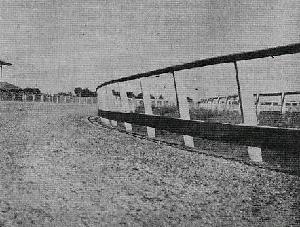 |
In an interview with Mr H E Goggin, secretary of the three Christchurch Clubs, a Calendar representative was informed that the grounds committees of the Canterbury Park and NZ Metropolitan Trotting Clubs are going into the question of a new fence on the inside of the racetrack. The Clubs are looking for the latest and best developments in such fences, and it is realised, said Mr Goggin, that the subject is one requiring a considerable amount of thought.
When the present fence was erected there was no hub board on it. There was a feeling at that time that the fence was safer without a hub board because a driver dislodged from a sulky had a chance of rolling underneath for safety. Mr Goggin pointed out that that is why the present fence has such a lean on. Later, in response to popular feeling, a hub board was added. The present fence is 4ft 7in high and the bottom of the angle of the lean is 8in. The centre of the hub board is 13in above the ground. Inside the fence is a drain. With the constant cleaning and cutting away of this drain the bottom of the posts is becoming exposed, mainly because of the angle at which they were sunk.
The club staff at Addington have constructed a model of another type of fence, 3ft 6in high, with an angle of only 2½in. A good many, on the other hand, are of the opinion that the fence should be straight, like that on the New Brighton racecourse.
The grounds committees extended an invitation to the committee of the Canterbury Owners' and Breeders' Trotting Club with a view to having a railing placed around the inside of the training track at New Brighton with the purpose of accustoming horses to it. The club acceded to this request and erected a fence for two furlongs on the inside of the training track. The fence is only 3ft 6in high, with the acute angle of 1ft, and it has no hub board. It is understood that a number of trainers are well satisfied with this type of fence.
In America on most tracks there is merely a hub board and no top rail on the fence. It would appear from photographs in American journals that horses do not hug the rails as they do in this country. They spread right across the straight, so probably there is not the same necessity for a hub board as there is on most of the leading Dominion tracks. In America, too, said Mr Goggin, it was considered that the best type of track was of a mile, with quarter-mile bends and quarter-mile 'stretches' or straights. This, he said, is considered the ideal type of course for trotting at speed, and the proof of this is contained in the fact that all the major records were mad on such tracks.
Mr Goggin concluded by remarking that the proposed alteration to the inside track at Addington is a major job which is wrapped up with any alterations that may be made to the size and shape of the track.
Credit: NZ Trotting Calendar 17Apr46
YEAR: 1941
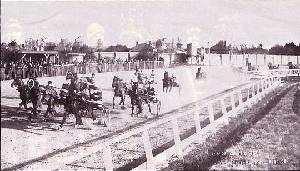 |
This photo shows the finish of the Ellersmere Handicap at the Canterbury Park meeting at Addington in June, 1941 won by Positive from Turco, Stylish Boy and Labour Day.
The interest in this photo is the false rail that can be seen at the straight entrance. Note: Just how long this was in use has not, as yet, been established.
Credit: HRWeekly 25Jul90
YEAR: 1930
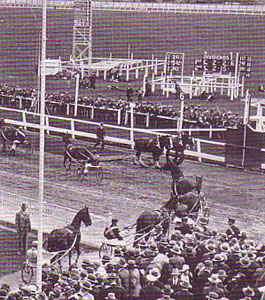 |
This photo appears in 'The Roydon Heritage' by Sir Roy McKenzie and was taken in the 1930s.
It is interesting for a number of reasons.
The draft horses harrowing the track.
The drivers in the next race are indicated on the tall frame at the left of the indicators.
The place dividend was only paid out on the first and second horses
The crowd was premitted in the middle of the course.
YEAR: 1930
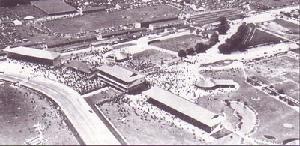 |
Credit: THE CUP 1904-2003
YEAR: 1928
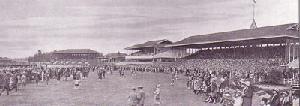 |
Credit: The Cup 1904-2003
YEAR: 1926
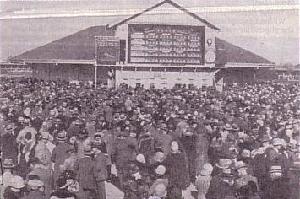 |
Crowds round the inside totalisator.£39,708 was on the totalisator on Cup Day 1926.
Credit: NZ HRWeekly 16Nov88
| << PREVIOUS | 1 2 3 4 | NEXT >> |